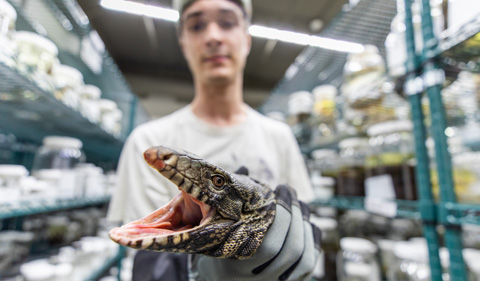
Dr. Lance McBrayer with his students on the Tegu lizard project. Photo by Jonathan Chick, Georgia Southern University
by Hannah Cordes
Ohio University alumnus Dr. Lance McBrayer was featured in Smithsonian Magazine for his recent research on invasive Tegu lizards in Georgia
- See the Smithsonian article, These Four-Foot Lizards Will Eat Anything—and They’re Invading the Southeastern U.S.
McBrayer earned a Biological Sciences Ph.D. in 2002 from the College of Arts & Sciences at OHIO. His interest in lizards stems from his years at the undergraduate level, but at the time all his research was being done only on captive animals. McBrayer wrote his dissertation on lizards in Southern Africa and has only broadened his knowledge since then. At OHIO, he was surrounded by a great cohort of graduate students. He was advised by Drs. Stephen Reilly, Donald Miles, Scott Moody, and others who prepared him for his professional career as a professor and researcher.
Tegu lizards have a long history of domestic breeding and make fairly good house pets. Unfortunately, in the 1980s many captive Tegus escaped in south Florida and began disrupting the natural ecosystem. In 2019, the Department of Natural Resources in Georgia documented sightings of Tegu lizards and contacted McBrayer since he is a lizard ecologist with a lot of specialized knowledge in this area. After receiving funding from the United States Geological Survey, McBrayer and his team began live trapping the lizards to curtail their spread and to collect data on them. His team is trying to understand what are they eating, how are they using the landscape, and if they breeding, etc. All of these questions are imperative to understanding the effect these animals are having on the native wildlife in Georgia.

Dr. Lance McBrayer’s student Michael Brennen with a Tegu lizard. Photo by Jonathan Chick, Georgia Southern University
In some ways, Tegus are very similar to raccoons in that they are generalists and eat whatever they can find. Tegus are efficient eggs predators, but also eat hidden prey like frogs and bugs in leaf litter, and even fruit. This poses a number of issues. If allowed to spread, Tegus will likely to impact native species such as indigo snakes and gopher tortoises by eating their eggs and would also eat ground nesting birds and their eggs or chicks.
Working with the Georgia DNR, McBrayer and his team have publicized the Tegu problem such that now about 70 percent of the local population is aware of what Tegus are and that they should be reported if seen. He expects this number to rise in the future as they will continue to educate the public. They hope that citizens will learn to remove animals from the wild themselves since introduced species are not protected by law. Also they anticipate more people will report Tegu sightings so the team may then remove them from the wild.
Although his team is handling the situation very well, the problem of the introduction of nonnative species in Georgia, especially reptiles, is only likely to grow in the next five years. Reptiles are very good at stowing away in or on human cargo such as tractors, boat trailers, nursery shipments, etc. and then many species may thrive in new environments without predators or competitors. Thus in the future, McBrayer does not see the invasive species issue going away, although he does believe that it is possible to eradicate Tegu lizards from Georgia with sustained effort of reporting sightings, trapping, and data collection.



















Comments